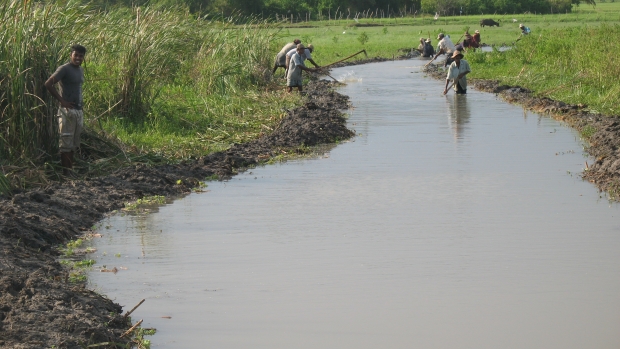Grants :: Small Grant Facilities :: Removing cattail from a village drainage canal
Removing cattail from a village drainage canal

Cattail removal , Sri Lanka © KEkaratne , 2009
Objectives
This project had three main objectives:
- to increase the income of lagoon communities in an environmentally friendly fashion;
- to raise the standard of living in those communities; and
- to protect the Lunama lagoon ecosystem.
Background
The aquatic reed Typha angustifolia, or cattail, grows on lake margins and in marshes, often in dense colonies, and is considered a weed when it invades managed wetlands. The village of Lunama lies in the district of Hambantota on Sri Lanka’s south-east coast. The main livelihood of villagers living close to the coast is fishing, whereas those living inland practise agriculture. The majority of farmers grow rice; others grow vegetables. An irrigation canal supplies water to the rice fields, and any excess water drains into nearby Lunama lagoon through an outlet canal. In recent times, the lagoon end of this canal has been blocked by fast-spreading cattail growth, impeding the drainage of about 10 hectares of rice fields belonging to 25 farmers. This has made the fields uncultivable and also affected the hydrology of Lunama lagoon. With a small grant from MFF, the Youth Enterprise Information Centre, a local NGO, undertook the clearing of the cattail with the affected farmers.
This project also aimed to conserve the ecosystem of the Lunama lagoon and help the surrounding community to supplement its income. It sought to improve the income of the 25 paddy farmers living near the lagoon by removing the cattail from the outlet canal. It also sought to encourage 22 vegetable farmers from Palugaswewa Farm to follow environmentally friendly practices, and to raise awareness of sustainable production practices among the 47 target farmers and 28 lagoon fishermen.
Target beneficiaries
Communities living in the Lunama area.
Outputs
- A 25% increase in the incomes of 25 rice farmers active in both the Yala (May–August) and Maha (September–March) seasons.
- Delivery of three awareness programmes for 28 lagoon fishermen and three programmes for 47 farmers.
- Removal of cattail from a 0.4 hectare area.
- The erection of fences around an 8.9 hectare block of Palugaswewa Farm and another farm of 16.2 hectares.
- Cultivation of at least five vegetable varieties by 22 farmers in both the Yala and Maha seasons.
Accomplishments and challenges
The original project plan was to remove cattail from a 2,500 m² area (i.e. a 500-m length of the 5-m wide outlet canal extending upstream from the lagoon). By the end of the project, however, 3,750 m² of the canal had been cleared of the invasive species. The farmers cleared the canal by hand instead of using machinery as budgeted in the project proposal. Contributing their labour allowed them to increase the cleared area by 1,250 m², 50% more than planned.
This effort has restored the water flow in the canal, improving the hydrological balance of Lunama lagoon.
The awareness programmes were successful in teaching the community sustainable production practices. The 25 rice farmers active during the Yala and Maha seasons saw their income rise by a quarter, and the 22 targeted vegetable farmers adopted at least five different varieties of vegetables for growing throughout the year.
Challenges
A severe drought limited the scale of planting.
Contributions to cross-cutting themes
Beneficiaries are males.
Lessons Learned
Giving local communities the responsibility to make decisions and respecting those decisions helps to achieve set goals.
Project Facts
Country
Location
Rekawa, Ussangoda and Kalametiya (RUK) area, Sri Lanka
Topic
Duration
1st Feb 2009 to 30th Sep 2009
MFF Grant Amount
US$4,386
Implementing Partner
Youth Enterprise Information Centre
Malpeththawa, Ambalantota,
Sri Lanka
Tel: +94 47 2223658
